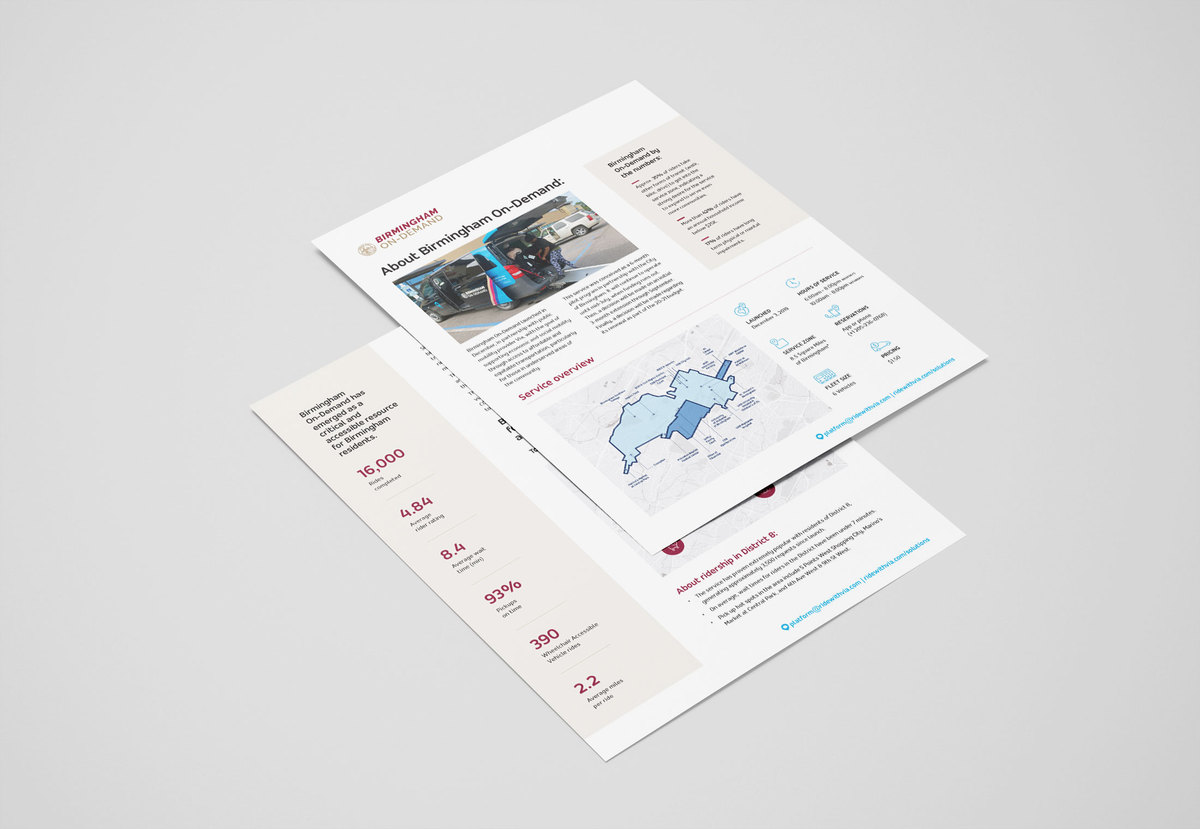Our ability to move conveniently and affordably between our homes, work, school, childcare providers, and healthcare determines our ability to thrive. The transportation systems that enable this movement play such a crucial role in our everyday lives, that any changes to these systems — even positive ones — can naturally be a source of apprehension. Taking a high-touch and proactive approach to community engagement helps mitigate concerns — while also turning would-be opponents into your biggest advocates. Service changes can be particularly fear-inducing for our most vulnerable populations, for whom public transit serves as a vital lifeline with no easy replacement. These fears are only exacerbated when there’s a lack of information (or misinformation) as to what this new form of public transit really means for the community. Concerns about cost, access for those with accessibility needs and/or lack technology, service coverage, and more, routinely create opposition to projects before they even get off the ground.
Taking a high-touch and proactive approach to community engagement helps mitigate concerns, while also turning would-be opponents into your biggest advocates. Support from the community at-large is essential to ensure a smooth launch and set the scene for the service’s continued success, funding, and growth. From planning, implementation, and beyond, community engagement should be a critical component of your project plan.

Consulting and planning.
Ideally, the community engagement process begins during the scoping and planning phase of your project. This allows for the maximum time to incorporate feedback from key stakeholders into the final service design and ensures the community’s needs are being met. Starting community engagement early in the process also allows ample time to educate riders and stakeholders, alleviating any concerns. Here’s how to approach it:
1. Map out any subcommunities of riders that may be highly sensitive to changing dynamics or might require a higher-touch approach in order to drive adoption of the new service.
Examples of communities to keep in mind:
| Higher Barriers To Entry | Sensitive to Changing Dynamics |
| Seniors | Unions (driver unions, call center unions, etc) |
| Unbanked/Cash preferred riders | Advocacy groups |
| Riders with accessibility needs | Elected officials (City Council, Mayor) |
| Riders without access to smartphones | Civic and business leaders |
| Homeless populations | Major local employers |
| Non-native English speakers |
2. Once you’ve mapped out these key groups, think about your service design and how it could help preempt their concerns. Accessibility might be an issue? Plan to include wheelchair-accessible vehicles in your fleet, or consider enabling point-to-point trips for mobility-impaired riders.
3. Get in front of the community dialogue by developing materials that proactively address the features of your new service. Think pamphlets, mailers, videos, or physical or digital advertisements that explain the mechanics of the service, how riders will book, show a proposed service zone, and outline a proposed cost. Be sure to address how riders in high-barrier groups will be able to access the service such as including information around phone booking, voucher payment, and accessibility features.
4. Feedback is your friend. Within your materials, consider leveraging call-out questions, offering surveys, or convening focus groups to involve the community in the planning process. Soliciting feedback on key open questions can help shape the fine details of a service — like the precise service zone — and also earn stakeholder buy-in.
 A sample pamphlet, created for Auckland Transit in New Zealand.
A sample pamphlet, created for Auckland Transit in New Zealand.
5. Plan to speak with advocacy groups, elected officials, civic and business leaders, and major local employers as part of your broader community outreach. With unions, it’s important to map out any contractual disclosure and grievance processes. We strongly recommend maintaining open and transparent dialogue with union representatives and getting them involved as early as possible. Where feasible, incorporate their feedback into service considerations. For example, if drivers are concerned about cannibalization of existing fixed route services, consider including multimodal offerings in your app to support first-and-last mile connections.
Launching your service.
Now that it’s time to start getting riders ready for day 1, you can build off of the work that you already started. Leverage the groups you’ve already established relationships with to help distribute key information about the service, and build a list of other organizations that can be helpful in getting the word out. These can include libraries, health centers, care facilities, civic groups, and social services. Don’t be shy in requesting that organizations use their connections to quickly expand your reach. A simple “Who’s missing?” often helps to open up the conversation and find other key allies that can help get the word out. At this stage, you can:
- Work with these groups to understand which service offerings are most impactful to their unique membership.
- Offer to conduct training sessions or create training videos for staff of these organizations to get them up to speed, as they’re often the first line of assistance for vulnerable riders and can provide an extra layer of on-the-ground support.
- Make it simple for these groups to amplify your message. Organizing materials into a “digital packet” for quick access to all multi-channel marketing assets is a highly effective way to make sure they’re easy and effective to distribute.
In projects where there is a cohort of existing users that are transitioning from a legacy service, taking an individual approach to engagement can be particularly effective.
Where existing data allows, build a list of users and offer to do one-on-one phone calls to help get them set up, ready to ride, and alleviate any concerns. As their first interaction with the service, it can impact how much they promote the service to their peers, so it’s important to keep a detailed record of their feedback, both positive and negative.
Where data isn’t available, begin to post information about the service change as early as possible and in as many places as possible (existing bus stops, on local websites and Facebook groups, etc.) Create an email address, feedback form, or phone line where concerned riders can call for more information and to get help setting up their new account. The primary goal for this phase should be to have as many legacy riders as possible set up with a new account before Day One of operations, leaving no one behind.

Supporting an ongoing project.
Congrats — your service is live! Now it’s time to leverage the great rapport you’ve built with the community to drive growth and continuously improve.
- See how things are going: A few weeks after launch, hold a check-in with the organizations and riders you’ve worked with in earlier phases. Use this feedback to adjust service design or marketing and outreach materials, if needed. Engaging in regular dialogue with the community can 1) help preempt small issues and prevent them from turning into big ones, 2) help you understand public sentiment regarding the service, and 3) inform and prioritize new initiatives.
- Share performance metrics: Keep advocacy groups and elected officials informed of the success and progress of the service. Sharing data helps drive support for eventual budget and contract renewal or expansion. The most effective materials are those that are tailored to the unique interests of each group, so consider breaking out ridership information by the voting district of a particular official, or by demographic data of a specific community an advocacy group works with. The best materials for these ongoing efforts include 2-pagers, presentations to the city council, and video testimonials.
 A sample 2-pager, created for Birmingham City Council in Alabama, US.
A sample 2-pager, created for Birmingham City Council in Alabama, US.
As you look towards renewal and potential expansion, consider other local stakeholders who may be strong candidates to invest in your service. Civic associations, business groups, major employers, and local colleges and universities might consider buying into the service to help fund expansion, or utilize the service for their own advertising.
A thoughtful and proactive approach to community engagement is well worth the effort to ensure your service meets the needs of the public, garners broad and vocal support, and even finds new avenues for funding. And, while the work is never truly over, laying a solid foundation with a comprehensive community engagement plan is always an important step in building transit services that last for years to come.




